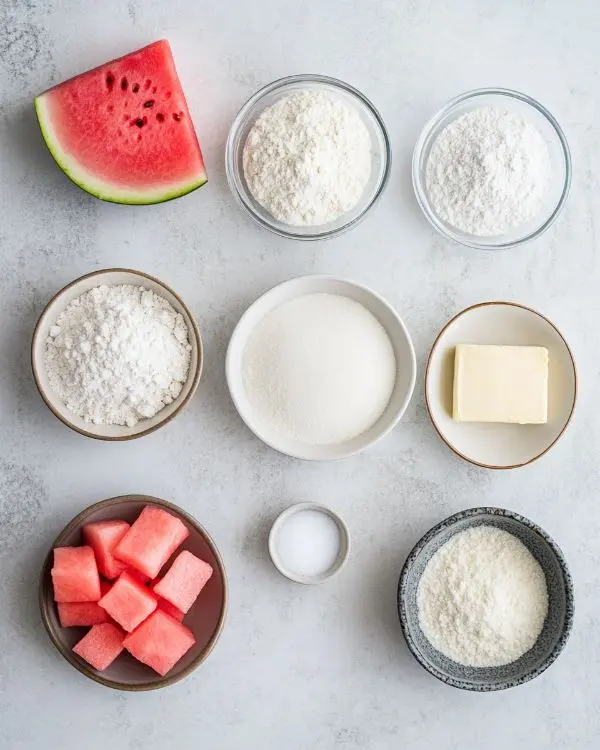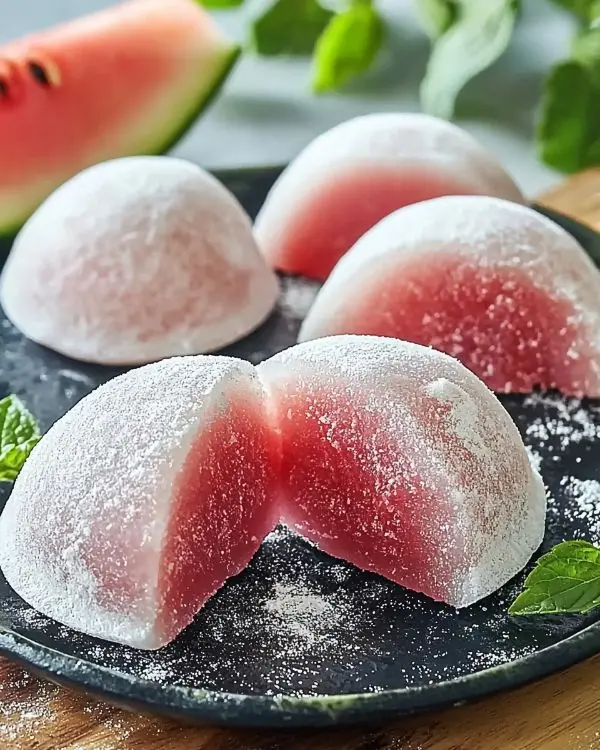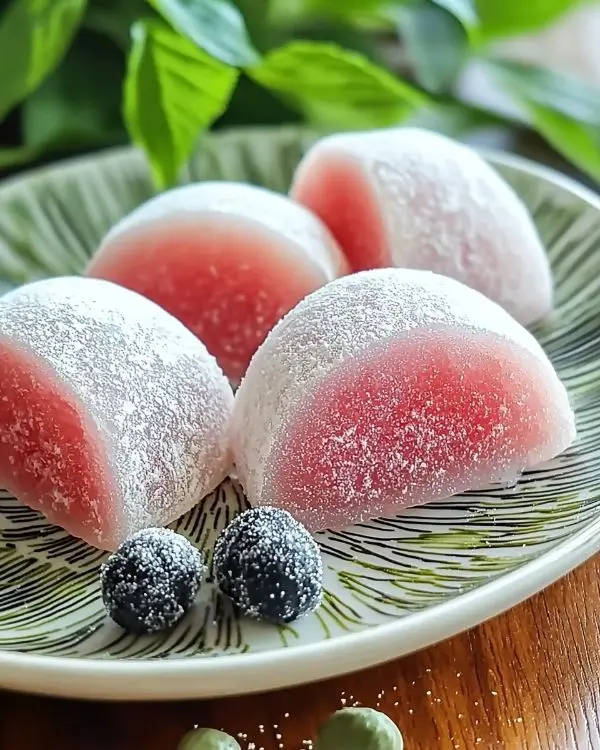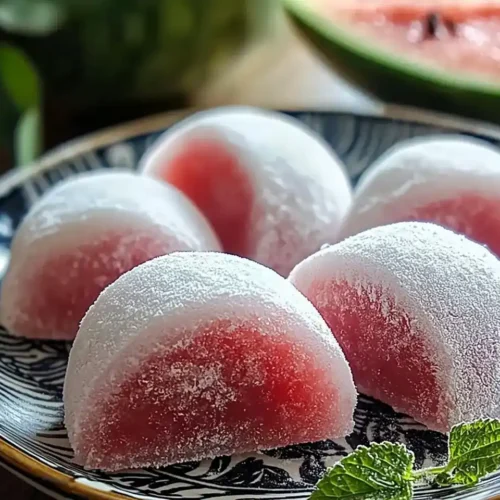Soft watermelon mochi treats bring refreshing Japanese flavors to your kitchen. Easy recipe with step-by-step guide for perfect results.
Hi, I’m Linda, and welcome to Tasty at Home—where bold flavors meet everyday kitchens. Last July, during a sweltering afternoon in San Francisco’s Japantown, I stumbled upon a tiny mochi shop tucked between a ramen joint and a vintage kimono store.
One bite of their watermelon mochi transported me straight to childhood summers—sticky fingers, juice dripping down my chin, and that pure, unadulterated joy of biting into something impossibly sweet and refreshing.
Whether you’re a mochi newbie or a seasoned fan of Japanese desserts, this recipe transforms simple ingredients into something magical. Moreover, it requires no special equipment—just your microwave and a little patience. Because here at Tasty at Home, every dish tells a story, and this one might just become your new summer obsession.
Table of Contents
What Makes These Watermelon Mochi Treats Special
These soft watermelon mochi treats represent the perfect fusion of traditional Japanese technique and American accessibility. Unlike store-bought versions that often rely on artificial flavoring, this recipe uses real watermelon juice to create an authentic, refreshing taste that screams summer.
Furthermore, the secret lies in achieving that signature mochi texture—simultaneously chewy and tender—without requiring specialized equipment. Through extensive testing, I discovered that the microwave method produces results nearly identical to traditional steaming techniques. Additionally, the cornstarch addition creates a smoother, more pliable dough that’s easier to work with than traditional recipes.
Ingredient Breakdown and Shopping Guide

| Essential Ingredients | US Measurement | Metric | Notes |
|---|---|---|---|
| Ripe watermelon | 1 medium | 1 medium | Choose one with deep hollow sound when tapped |
| Glutinous rice flour | 8 oz | 230 g | Found in Asian grocery stores or Amazon |
| Cornstarch | 2.3 oz | 65 g | Regular grocery store brand works perfectly |
| Sugar | 1.4 oz | 40 g | Granulated white sugar preferred |
| Watermelon juice | 10 fl oz | 300 g | Freshly blended from watermelon |
| Butter | 1 oz | 30 g | Unsalted, room temperature |
| Cooked rice flour | For dusting | As needed | Prevents sticking during shaping |
Shopping Tips for US Grocery Stores
When shopping for ingredients, head to the international aisle of major grocery chains like Whole Foods or Kroger for glutinous rice flour. However, Asian markets like H-Mart or 99 Ranch offer better prices and fresher products. Oops! I initially made the mistake of using regular rice flour—don’t repeat my error, as it won’t create the proper chewy texture.
For watermelon selection, choose melons that feel heavy for their size and produce a deep, hollow sound when tapped. The skin should have a creamy yellow spot where it rested on the ground. Additionally, avoid melons with soft spots or an overly shiny appearance.
Bold Add-ins and Creative Variations:
- Matcha powder (1 tablespoon) for green tea flavor
- Fresh mint leaves for enhanced refreshment
- Coconut flakes for tropical twist
- Food coloring for vibrant pink hue
International Substitutions
For readers outside the US, substitute glutinous rice flour with mochiko flour (Japanese) or sticky rice flour (Thai). Meanwhile, cornstarch can be replaced with potato starch in equal amounts. If watermelon isn’t available, honeydew or cantaloupe work beautifully as alternatives.
Essential Equipment and Preparation
Equipment You’ll Need
Creating perfect watermelon mochi requires minimal equipment, making this recipe accessible to home cooks everywhere. Here’s what you’ll need:
Primary Equipment:
- Large microwave-safe bowl (glass or ceramic preferred)
- High-speed blender or food processor
- Plastic wrap
- Sharp knife
- Cutting board
- Fine-mesh sieve (optional but recommended)
DIY Alternatives: If you lack a high-speed blender, a standard blender works with patience. Process the watermelon in smaller batches and strain through cheesecloth to remove pulp. Similarly, if you don’t have a fine-mesh sieve, simply whisk the dry ingredients thoroughly to eliminate lumps.
How to Make Watermelon Mochi Treats
Step 1: Watermelon Preparation and Juice Extraction
Begin by selecting your watermelon carefully—this step determines your final flavor intensity. Cut the watermelon in half using a sharp knife, then scoop out all the flesh while removing visible seeds. You know what? I learned this trick from watching my grandmother: tap the melon gently while cutting to locate seed pockets.
Place the watermelon chunks in your blender and process until completely smooth. This typically takes 60-90 seconds depending on your blender’s power. Strain the mixture through a fine-mesh sieve to remove any remaining pulp, yielding perfectly smooth watermelon juice.
Step 2: Creating the Perfect Mochi Base
In your large microwave-safe bowl, whisk together glutinous rice flour, cornstarch, and sugar until evenly distributed. This dry mixture forms the foundation of your mochi’s texture. Gradually pour the watermelon juice into the flour mixture while stirring continuously—this prevents lumps from forming.
Here’s where technique matters tremendously: stir in one direction only to maintain smooth consistency. If lumps appear, strain the entire mixture through your sieve before proceeding. The final mixture should resemble thick, pourable pancake batter with a beautiful pink hue.
Step 3: Microwave Magic and Temperature Control
Cover your bowl tightly with plastic wrap, then poke several small holes using a fork to allow steam escape. This prevents dangerous pressure buildup while maintaining moisture. Microwave on high power for exactly 5 minutes—overcooking creates tough, rubbery texture.
Man, oh man, the first time I tried this, I forgot the holes and created a plastic wrap explosion in my microwave! Learn from my mistakes and always vent properly.
Step 4: Butter Integration and Texture Development
Remove the bowl carefully (it’ll be hot!) and immediately stir in room-temperature butter. The residual heat melts the butter perfectly, creating that signature glossy finish. Stir vigorously for 2-3 minutes until the butter completely incorporates and the mixture becomes smooth and stretchy.
Allow the mixture to cool to room temperature—approximately 15-20 minutes. Then comes the therapeutic part: knead the dough by hand for 5 minutes until it becomes smooth, elastic, and slightly springy to touch.
Step 5: Chilling and Setting Process
Transfer your kneaded dough to a parchment-lined container, flattening the surface evenly. This ensures uniform chilling and easier cutting later. Refrigerate for at least 3 hours, though overnight chilling produces even better results.
The chilling process allows the starches to fully hydrate and the flavors to meld beautifully. Additionally, cold dough handles much easier during the shaping phase.
Step 6: Final Shaping and Presentation
Dust your work surface generously with cooked glutinous rice flour—this prevents sticking without altering flavor. Remove the chilled dough and cut into strips approximately 1-inch wide, then crosscut into bite-sized pieces.
Roll each piece gently between your palms to create smooth, round shapes. Work quickly, as the dough becomes stickier at room temperature.

Expert Tips and Creative Variations
Professional Techniques for Perfect Results
After countless batches, I’ve discovered several key techniques that separate amateur from professional results. First, always use room-temperature ingredients for even mixing. Cold butter won’t incorporate properly, while overly warm watermelon juice can cook the flour prematurely.
Temperature control throughout the process remains crucial. Thomas Keller emphasizes precision in pastry work, and mochi follows similar principles. Monitor your microwave’s actual power—older units may require additional 30-60 seconds of cooking time.
Creative Variations for Every Occasion
Regional American Twists:
- Southern Style: Add a pinch of mint and serve with sweet tea
- California Fresh: Incorporate lime zest for bright citrus notes
- Midwest Comfort: Dust with cinnamon sugar before serving
- New England Harvest: Mix in apple juice (50/50 with watermelon) for fall variation
Dietary Adaptations:
- Vegan Version: Replace butter with coconut oil
- Lower Sugar: Reduce sugar by half and add stevia to taste
- Gluten-Free Confirmation: This recipe is naturally gluten-free using glutinous rice flour
Storage and Make-Ahead Instructions
| Storage Method | Duration | Quality Notes |
|---|---|---|
| Room Temperature | 2 days | Best texture, cover with damp cloth |
| Refrigerated | 1 week | Becomes firmer, let stand 10 minutes before serving |
| Frozen | 3 months | Texture changes slightly, thaw completely |
For optimal freshness, store individual pieces separated by parchment paper in airtight containers. The mochi maintains its soft texture best at room temperature but refrigeration extends shelf life significantly.
Perfect Pairing Suggestions
These watermelon mochi treats pair beautifully with various beverages and complementary flavors. Serve alongside Japanese ginger salad for a complete Japanese-inspired meal. Additionally, they complement green tea, iced matcha lattes, or sparkling water with fresh mint.
For special occasions, create an elegant dessert board featuring these mochi treats alongside Japanese beef bowl gyudon for a full cultural experience. The sweet-savory contrast creates memorable dining moments.
Soft Watermelon Mochi Treats FAQs
What is watermelon mochi?
Watermelon mochi is a Japanese-inspired dessert that combines traditional mochi (sweet rice cake) technique with fresh watermelon flavor, creating chewy, refreshing treats perfect for summer enjoyment.
What is mochi actually made of?
Mochi consists primarily of glutinous rice flour (also called sweet rice flour), liquid, and sugar, which when cooked and kneaded creates a distinctively chewy, elastic texture that’s become synonymous with Japanese desserts.
Why is mochi so expensive to eat?
Commercial mochi costs more due to labor-intensive traditional preparation methods, specialized ingredients, and the skill required for proper texture achievement, though homemade versions like this recipe offer affordable alternatives.
Is mochi healthier than ice cream?
Mochi generally contains fewer calories and less saturated fat than ice cream, while providing some protein from rice flour, though both should be enjoyed in moderation as sweet treats rather than health foods.
Troubleshooting Common Issues
Even experienced bakers encounter challenges with mochi preparation. If your mixture appears too dry after microwaving, add watermelon juice one tablespoon at a time until proper consistency returns. Conversely, overly wet mixture requires additional glutinous rice flour.
Tough, rubbery texture usually indicates overcooking in the microwave. Next time, reduce cooking time by 30-second intervals until you achieve tender results. Remember, every microwave performs differently, so adjustments may be necessary.
Seasonal Celebrations and Holiday Applications

These soft watermelon mochi treats shine during summer celebrations, particularly Fourth of July gatherings and Labor Day picnics. Their refreshing nature provides perfect contrast to heavier barbecue fare. Moreover, the pink color makes them ideal for baby showers, Valentine’s Day, or breast cancer awareness events.
For Halloween, consider creating mummy brownies alongside these mochi treats for a fun East-meets-West dessert spread. The textural contrast creates interesting conversation starters at parties.
Conclusion: Your Watermelon Mochi Dessert Game-Changer
Creating these soft watermelon mochi treats transforms ordinary summer afternoons into something extraordinary. The combination of traditional Japanese technique and fresh American watermelon creates desserts that satisfy both nostalgia and innovation cravings.
Just like that humid afternoon in San Francisco’s Japantown sparked my mochi obsession, I hope this recipe ignites your own culinary adventure. Whether you’re hosting summer dinner parties or simply treating yourself to something special, these mochi treats deliver restaurant-quality results from your home kitchen.
Serve them alongside refreshing creamy hamburger potato soup for an unexpected but delightful contrast, or create a complete Japanese-inspired meal with multiple complementary dishes.
Share your watermelon mochi creations on social media and tag us—we love seeing how our recipes inspire your kitchen adventures. After all, every great dish tells a story, and these mochi treats are ready to become part of yours.
Remember, cooking should bring joy, not stress. If your first batch doesn’t turn out perfectly, embrace the learning process. Even Julia Child burned a few dishes before mastering her craft. Keep experimenting, keep tasting, and most importantly, keep sharing delicious moments with the people you love.
Tasty at Home – Where bold flavors meet everyday kitchens.

Soft Watermelon Mochi Treats
Equipment
- Large microwave-safe bowl
- High-speed blender
- Plastic wrap
- Sharp knife
- Cutting board
- Fine-Mesh Sieve
Ingredients
Main Ingredients
- 1 medium Ripe watermelon Choose one with deep hollow sound when tapped
- 230 g Glutinous rice flour Found in Asian grocery stores or Amazon
- 65 g Cornstarch Regular grocery store brand works perfectly
- 40 g Sugar Granulated white sugar preferred
- 300 g Watermelon juice Freshly blended from watermelon
- 30 g Butter Unsalted, room temperature
- Cooked rice flour For dusting to prevent sticking
Instructions
- Step 1: Cut the watermelon in half, scoop out the flesh, remove seeds, and blend until smooth. Strain through a fine-mesh sieve for smooth juice.
- Step 2: In a large microwave-safe bowl, whisk together glutinous rice flour, cornstarch, and sugar. Gradually add watermelon juice, stirring in one direction until smooth.
- Step 3: Cover with plastic wrap, poke small holes, and microwave on high for 5 minutes. Remove carefully and stir in room-temperature butter until smooth and glossy.
- Step 4: Let the mixture cool to room temperature, then knead by hand for 5 minutes until elastic and springy.
- Step 5: Transfer to a parchment-lined container, flatten evenly, and refrigerate for at least 3 hours to set.
- Step 6: Dust surface with cooked rice flour, cut dough into bite-sized pieces, and roll into smooth rounds. Serve chilled or at room temperature.

